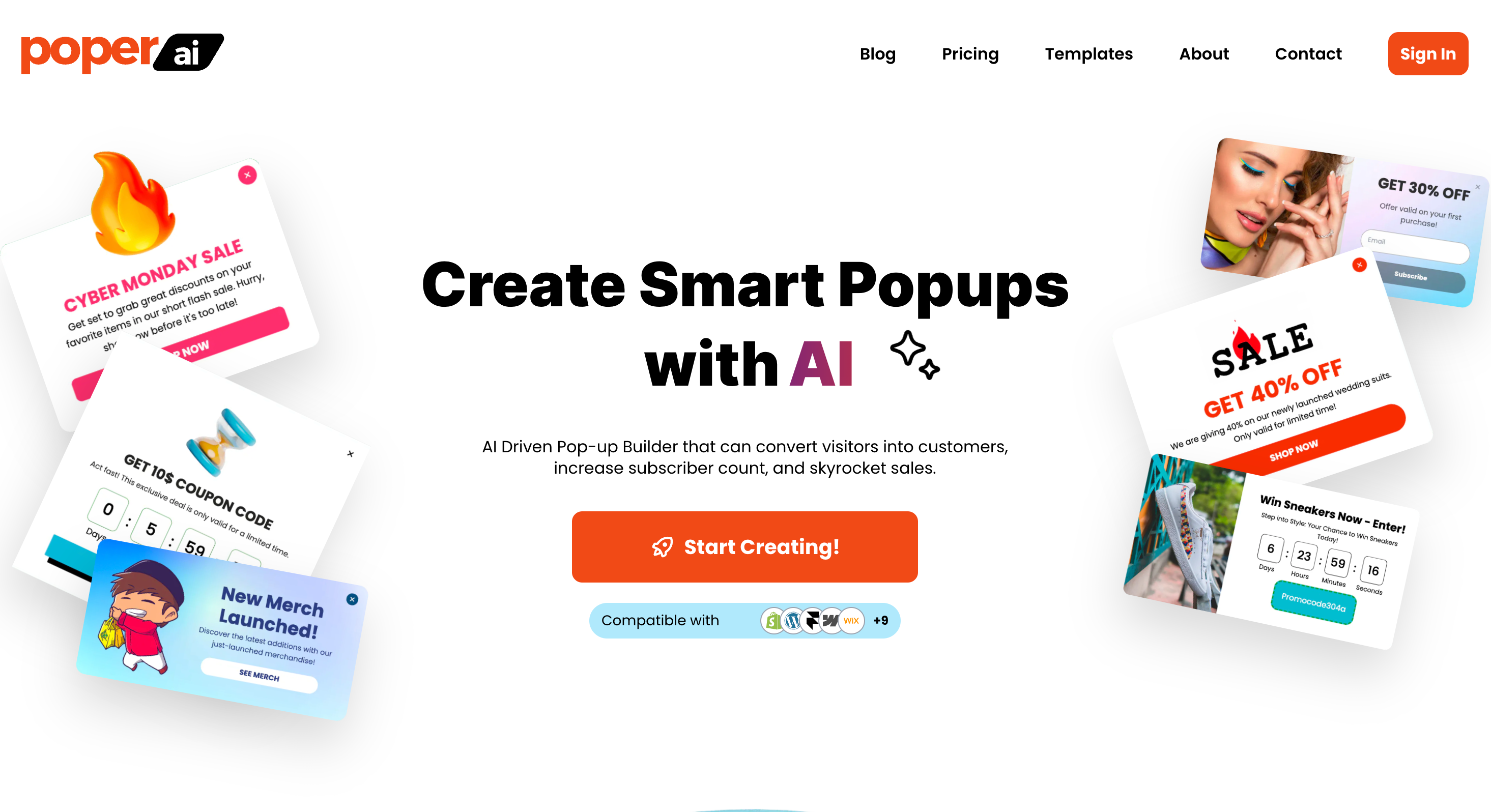People don't buy what you do; they buy why you do it. And what you do simply proves what you believe.
Simon Sinek
In the digital marketing landscape, offering free samples can be a powerful strategy to attract potential customers and build trust. Free sample popups are an effective way to promote these offers by capturing the attention of website visitors and encouraging them to take action. This article explores the definition, importance, and strategies for using free sample popups to enhance your marketing efforts.
Importance of Offering Free Samples in Digital Marketing:
Offering free samples is a proven marketing tactic that allows potential customers to experience your product without commitment. This strategy helps in:
Building Trust: Allowing users to try your product risk-free builds credibility and trust.
Driving Conversions: Free samples can convert curious visitors into loyal customers.
Gathering Data: Collecting customer data through popups helps in future marketing efforts.
Understanding Free Sample Popups

What are Free Sample Popups?
Free sample popups are promotional tools designed to offer visitors a free sample of your product. These popups appear at strategic points during the user's visit to capture their interest and encourage them to provide their contact information in exchange for a sample.
Why Use Free Sample Popups?
Using free sample popups is beneficial because they:
Increase Engagement: They grab attention and engage visitors who might otherwise leave the site.
Promote Product Trials: Offering a free sample encourages users to try your product, increasing the likelihood of a future purchase.
Capture Leads: Collect valuable contact information for follow-up marketing campaigns.
Types of Free Sample Popups
There are various types of free sample popups to choose from, depending on your marketing goals:
Lightbox Popups: Appear in the center of the screen, dimming the background to focus attention.
Slide-In Popups: Slide in from the side or bottom of the screen without obstructing the main content.
Floating Bar Popups: Remain at the top or bottom of the page as users scroll.
Exit-Intent Popups: Triggered when a user is about to leave the site, offering a last chance to engage.
5 Benefits of Using Free Sample Popups

1. Increased Conversion Rates
Free sample popups significantly increase conversion rates by providing a low-risk way for visitors to try your product. When visitors receive something for free, they are more likely to engage and eventually make a purchase.
2. Enhanced User Engagement
Engaging visitors with a free offer keeps them on your site longer and encourages interaction. This engagement can lead to higher retention rates and increased customer loyalty.
3. Building Trust with Potential Customers
Offering free samples helps in building trust with potential customers. When users can try your product without any financial commitment, it demonstrates confidence in the quality of your product and fosters trust.
4. Driving Traffic to Specific Products
Free sample popups can drive targeted traffic to specific products you want to promote. Highlighting new or underperforming products with a free sample can boost their visibility and sales.
5. Collecting Valuable Customer Data
Free sample popups provide an excellent opportunity to collect customer data. By requiring users to enter their contact information, you can build a valuable database for future marketing efforts.
Key Features of Effective Free Sample Popups

Eye-Catching Design
An eye-catching design is crucial for grabbing the visitor's attention. Use bold colors, attractive images, and clear fonts to make your popup stand out.
Clear and Compelling Copy
The text on your popup should be concise and persuasive. Clearly explain what the free sample is and how the visitor can benefit from it. Highlight any unique selling points of your product.
Strong Call-to-Action (CTA)
A strong CTA is essential for converting visitors. Use action-oriented language and make the CTA button prominent. Examples include "Get Your Free Sample" or "Try It Now".
Mobile-Friendly Layout
With many users accessing websites on mobile devices, your popups must be mobile-responsive. Ensure they look great and function well on all screen sizes.
Personalization Options
Personalizing your popups can significantly increase their effectiveness. Use data to tailor the popup to individual visitors, such as greeting them by name or suggesting a product they might like based on their browsing history.
Placement and Timing Strategies

Effective placement and timing are crucial for maximizing the impact of your free sample popups. Strategic placement ensures that your popups are highly visible to visitors, while optimal timing enhances user experience and conversion rates.
Optimal Placement for Maximum Visibility
Positioning your popups in the right location on your website can significantly affect their performance. Here are some recommended placements:
Center of the Screen: Commands attention immediately by appearing prominently in the middle of the screen.
Top or Bottom Bar: Fixed bars that stay visible as the user scrolls, providing a persistent call-to-action.
Slide-In from the Side: Draws attention subtly without interrupting the user experience.
Embedded in Content: Integrated within the page content, making the offer feel like a natural part of the browsing experience.
Best Times to Display Free Sample Popups
Timing is everything when it comes to popups. Displaying your popups at the right moment can make a significant difference in engagement and conversion rates. Consider these timing strategies:
On Page Load: Captures immediate attention, but should be used sparingly to avoid overwhelming visitors.
After X Seconds: Allows users to engage with the content before presenting the offer.
On Scroll: Displays the popup after the visitor has scrolled a certain percentage of the page, indicating interest.
Exit-Intent: Triggers the popup when a visitor is about to leave the site, providing a last chance to convert them.
Frequency of Display
Balancing the frequency of your popups is essential to avoid annoying your visitors. Best practices include:
Once per Session: Ensures that visitors see the popup without feeling harassed.
After a Set Number of Visits: Targets returning visitors who have shown repeated interest but haven’t yet taken action.
Based on User Behavior: Adjust the frequency according to how users interact with your site.
Using Exit-Intent Popups for Free Sample Offers
Exit-intent popups are highly effective because they provide a last opportunity to engage with visitors who are about to leave your site. Benefits include:
Reducing Bounce Rates: Captures attention just as visitors are about to leave, encouraging them to stay longer.
Increasing Conversion Rates: Offers a compelling reason to subscribe or engage, such as a free sample or discount.
Leveraging Poper for Free Sample Popups

Poper is a powerful tool that simplifies the process of creating and managing effective free sample popups. With its user-friendly interface and advanced features, Poper ensures that your popups are not only attractive but also highly effective.
Overview of Poper’s Features
Poper offers a variety of features designed to enhance your popup campaigns:
Customizable Templates: Choose from a wide range of templates and customize them to fit your brand.
Advanced Targeting: Show popups to specific audience segments based on various criteria.
A/B Testing: Test different versions of your popups to see which performs best.
Real-Time Analytics: Monitor the performance of your popups with detailed analytics.
Seamless Integrations: Connect with email marketing platforms, CRM systems, and other marketing tools.
Creating Free Sample Popups with Poper
Creating free sample popups with Poper is straightforward and efficient. Follow these steps to get started:
Sign Up and Log In: Create an account on Poper and log in to access the dashboard.
Choose a Template: Select a template from Poper’s library that suits your campaign goals.
Customize Design: Use Poper’s drag-and-drop editor to customize the design, including colors, fonts, and images.
Add Input Fields: Include fields for the visitor’s email address and any other necessary information.
Set Display Rules: Configure when and where your popup should appear, such as on specific pages or after a set amount of time.
Publish Popup: Once everything is set, publish the popup to make it live on your site.
Customizing Templates in Poper
Poper’s customization options allow you to create unique and engaging popups:
Design Flexibility: Modify the layout, colors, fonts, and images to match your brand’s aesthetics.
Interactive Elements: Add buttons, forms, and other interactive elements to enhance user engagement.
Animations: Use subtle animations to make your popup more dynamic and eye-catching.
Adding Triggers and Audience Filtering in Poper
Effective use of triggers and audience filtering can significantly boost the effectiveness of your popups:
Setting Triggers: Configure triggers to display popups based on specific user actions, such as scrolling, clicking, or attempting to leave the site.
Audience Filtering: Define your audience by using Poper’s filtering options, targeting visitors based on demographics, behavior, location, and device type.
Monitoring Performance with Poper
Poper’s analytics dashboard provides valuable insights into your popup performance:
Real-Time Data: Monitor key metrics such as conversion rate, click-through rate, and engagement rate in real time.
Detailed Reports: Generate detailed reports to analyze the effectiveness of your popups.
A/B Testing Results: View the results of your A/B tests to determine which popup versions perform best.
FAQs
What are the key elements of a successful free sample popup?
A successful free sample popup should have a clear and compelling headline, concise copy, a strong call-to-action, an eye-catching design, and mobile responsiveness. It should also offer a valuable incentive to encourage signups.
What are the best practices for designing free sample popups?
Best practices for designing free sample popups include keeping the design simple, using clear and concise messaging, ensuring fast loading times, and complying with privacy regulations. Personalization and A/B testing are also crucial.
Are there any legal considerations for offering free samples?
Yes, there are legal considerations. Ensure that you comply with privacy regulations such as GDPR and CCPA. Obtain explicit consent from users before collecting their data and provide a clear privacy policy.
Summary
Free sample popups are powerful tools for increasing engagement, building trust, and driving conversions. By following best practices and leveraging advanced features, you can create highly effective popups that resonate with your audience.
Definition and Importance: Free sample popups are effective for attracting potential customers and building trust.
Benefits: Increased conversion rates, enhanced user engagement, and valuable customer data collection.
Design and Placement: Eye-catching design, clear messaging, strategic placement, and optimal timing.
Using Poper: Simplifies the creation, customization, and optimization of free sample popups.
Ready to enhance your marketing strategy with free sample popups? Try Poper today and see the difference it can make for your business.




